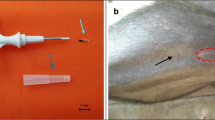Abstract
Use of gauze sponges that have been embedded with passive radio frequency identification (RFID) tags presents a high probability of reducing or eliminating instances of gossypiboma, or retained surgical sponge. The use of human counts during surgical operations, especially during instances where unexpected or emergency events occur, can result in errors where surgical instruments, most often gauze sponges, are retained within the patient’s body, leading to complications at a later date. Implementation of an automatic inventory record system, for instance, RFID, may greatly reduce these incidences by removing the human factor and would improve patient safety by eliminating the current sponge count protocol. Experiments performed by placing RFID-labeled sponges within an animal and removing them have demonstrated that tags are at least partially readable inside the body cavity and fully readable once removed, suggesting the possibility of an automated sponge count system pending further development of this technology.
Similar content being viewed by others
References
Christian CK, Gustafson ML, Roth EM, Sheridan TB, Gandhi TK, Dwyer K, Zinner MJ, Dierks MM (2006) A prospective study of patient safety in the operating room. Surgery 139:159–173
Gawande AA, Studdert DM, Orav EJ, Brennan TA, Zinner MJ (2003) Risk factors for retained instruments and sponges after surgery. N Engl J Med 348:229–235
Zbar AP, Agrawal A, Saeed IT, Utidjian MR (1998) Gossypiboma revisited: a case report and review of the literature. J R Coll Surg Edinb 43:417–418
Kaiser CW, Friedman S, Spurling KP, Slowick T, Kaiser HA (1996) The retained surgical sponge. Ann Surg 224:79–84
Clampitt HG, Jones EC (eds) (2006) RFID Certification Textbook. PWD Group Inc., Houston, TX
Bhuptani M, Moradpour S (2005) RFID Field Guide: Deploying Radio Frequency Identification Systems. Sun Microsystems, Santa Clara, CA
Shepard S (2005) RFID: Radio Frequency Identification. McGraw-Hill, New York
Macario A, Morris D, Morris S (2006) Initial clinical evaluation of a handheld device for detecting retained surgical gauze sponges using radiofrequency identification technology. Arch Surg 141:659–662
Author information
Authors and Affiliations
Corresponding author
Rights and permissions
About this article
Cite this article
Rogers, A., Jones, E. & Oleynikov, D. Radio frequency identification (RFID) applied to surgical sponges. Surg Endosc 21, 1235–1237 (2007). https://doi.org/10.1007/s00464-007-9308-7
Received:
Revised:
Accepted:
Published:
Issue Date:
DOI: https://doi.org/10.1007/s00464-007-9308-7




